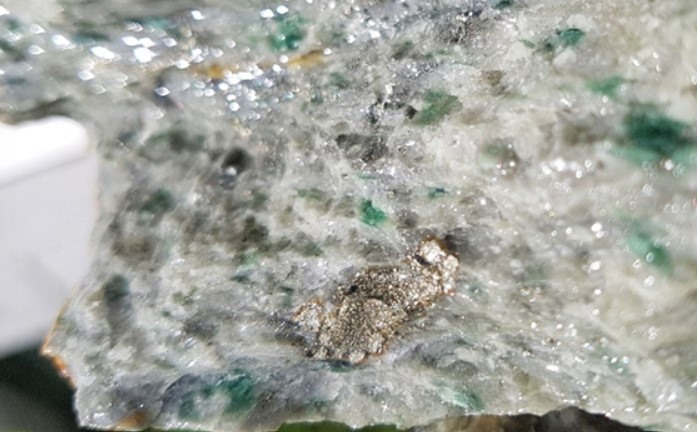GEOLOGY
Solid results for Laurion from ore sorting at Ishkoday polymetallic projectAfter a pair of tests completed at the Saskatchewan Research Council, (Laurion Mineral Exploration )
By Marilyn Scales June 6, 2023

Mineralized sample from the Ishkoday gold and base metals project.

Mineralized sample from the Ishkoday gold and base metals project.
Laurion Mineral Exploration photo
After a pair of tests completed at the Saskatchewan Research Council, Laurion Mineral Exploration (TSXV:LME; OTC:LMEFF) is pleased with the way material from the historical Sturgeon River mine surface stockpile responded to sensor-based ore sorting. The mine is part of the Ishkoday gold-base metals project 28 km northeast of Beardmore, Ont.
Laurion president and CEO Cynthia Le Sueur-Aquin said the mineralization from the stockpile responds well to both laser and colour sensor-based sorting. Ore sorting is being considered for its potential to reduce downstream processing volume and costs.
The first test campaign treated samples based on their gold content. They were subjected to X-ray transmission (XRT) which sorts by difference in particle density combined. Laser illumination was also tested, which was the more efficient method. Laser illumination sorting upgraded the sample by 75% (from 3.9 g/t to 10.4 g/t) with a sorting efficiency of 74.4%.
The second campaign treated a large sample of stockpiled material after it was crushed and split. Material below 10-mm was screened out, reducing the volume by 50%. One hundred +10-mm particles were then selected at random for laser and colorimetric sorting.
A semi-empirical model for laser sorting indicated that 69% of the mineralization could be rejected while losing only 0.6% of the gold to the reject pile. The material was upgraded by 220% (from 2.63 g/t to 8.42 g/t), a result that exceeded expectations.
Comparable results came from the colorimetric test. The volume was reduced by 60% with a loss of only 0.94% of the gold. The mineralized material was upgraded 145% (from 2.63 g/t to 6.44 g/t) in the accepts pile.
The Ishkoday property includes several past producers, including the Sturgeon River mine, which produced 73,322 oz. of gold and 15,929 oz. of silver when it was active from 1936 to 1942.
Read the informative corporate presentation on the Laurion website.
After a pair of tests completed at the Saskatchewan Research Council, Laurion Mineral Exploration (TSXV:LME; OTC:LMEFF) is pleased with the way material from the historical Sturgeon River mine surface stockpile responded to sensor-based ore sorting. The mine is part of the Ishkoday gold-base metals project 28 km northeast of Beardmore, Ont.
Laurion president and CEO Cynthia Le Sueur-Aquin said the mineralization from the stockpile responds well to both laser and colour sensor-based sorting. Ore sorting is being considered for its potential to reduce downstream processing volume and costs.
The first test campaign treated samples based on their gold content. They were subjected to X-ray transmission (XRT) which sorts by difference in particle density combined. Laser illumination was also tested, which was the more efficient method. Laser illumination sorting upgraded the sample by 75% (from 3.9 g/t to 10.4 g/t) with a sorting efficiency of 74.4%.
The second campaign treated a large sample of stockpiled material after it was crushed and split. Material below 10-mm was screened out, reducing the volume by 50%. One hundred +10-mm particles were then selected at random for laser and colorimetric sorting.
A semi-empirical model for laser sorting indicated that 69% of the mineralization could be rejected while losing only 0.6% of the gold to the reject pile. The material was upgraded by 220% (from 2.63 g/t to 8.42 g/t), a result that exceeded expectations.
Comparable results came from the colorimetric test. The volume was reduced by 60% with a loss of only 0.94% of the gold. The mineralized material was upgraded 145% (from 2.63 g/t to 6.44 g/t) in the accepts pile.
The Ishkoday property includes several past producers, including the Sturgeon River mine, which produced 73,322 oz. of gold and 15,929 oz. of silver when it was active from 1936 to 1942.
Read the informative corporate presentation on the Laurion website.
No comments:
Post a Comment